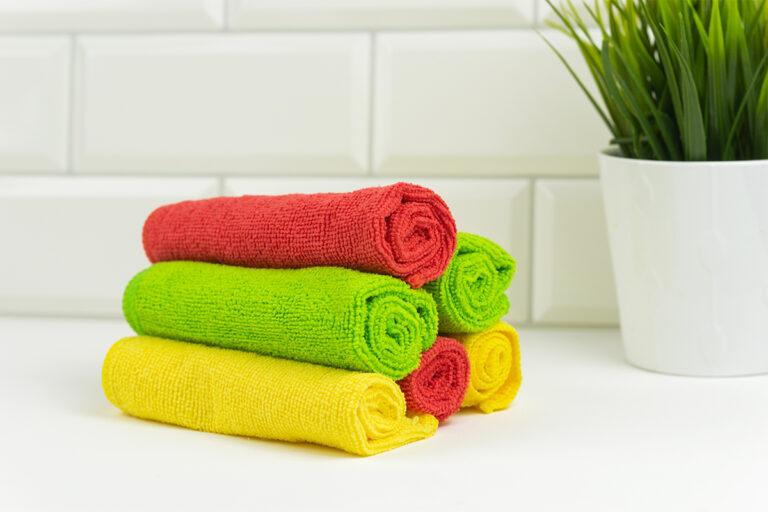Microfiber cloths have become necessary for professional and domestic cleaning thanks to their ability to remove dirt deeply and without aggressive chemicals. But how can you make the most of them? In this article, we find out how to use and maintain microfiber cloths to make them last a long time.
How to use microfiber cloths
Microfiber cloths can be used on different surfaces and with various detergents, depending on the treatment area. To get the most out of your cloths, here are some tips on how to use them correctly:
- Dry cleaning for dusting.
Use dry microfiber cloths to capture dust and dirt from surfaces such as furniture and floors. Thanks to the filament structure, microfibre cloths attract dust without dispersing it into the air. - Cleaning with mild detergents.
When using damp microfiber cloths, is important to choose a gentle cleanser and not be too aggressive. Avoid soaps that are too rich in chemicals or softeners. A neutral or natural detergent is ideal for not damaging the fibers and maintaining their effectiveness. - Cleaning on delicate surfaces
On more delicate surfaces, such as mirrors, glass, or screens, only use water or a specific glass cleaner. Microfibre, thanks to its softness, guarantees thorough cleaning without scratches or marks. - Deep cleaning with warm water
To remove stubborn dirt, you can use microfiber cloths dampened with warm water. Remember to wring out the cloth well before use to avoid excess water which could leave marks or damage the surfaces.
Martini SPA microfiber products
MartiniSPA offers a range of professional microfibre cloths designed to meet different cleaning needs. Among the top products we find:
- Multipurpose home cleaning microfibre cloths
A set of versatile cloths for glass, furniture and kitchen and bathroom surfaces. These cloths are designed to capture dirt without leaving traces, making them ideal for thorough and delicate cleaning. - Special ultra microfibre cloth for cars
A very absorbent and wear-resistant cloth, perfect for car care. It guarantees impeccable cleaning without scratches and streaks. - Microfibre floor cloth
This two-in-one microfibre and cotton cloth is perfect for cleaning all types of floors, from wood to tiles.
How to wash microfiber cloths
Washing your microfiber cloths properly is essential to maintain their effectiveness over time. Here are some useful tips:
- Machine washable
You can wash microfiber cloths in the washing machine at a low temperature (max 30°C) with a delicate detergent. Avoid using fabric softeners, which can compromise the structure of the filaments. - Hand wash
For cloths used for cleaning delicate surfaces, hand washing with warm water is best. - Drying
Dry the clothes in to open air. Using the dryer could shorten the life of the cloth. - Conservation
Store the cloths in a dry and dust-free place, so that they are ready for use without accumulating impurities.
Smaltimento dei panni in microfibra
When microfiber cloths reach the end of their useful life, it is important to dispose of them correctly. Microfiber is a synthetic material and not biodegradable, therefore it must not be thrown into organic waste. Here are some disposal guidelines:
- Waste sorting
Check the local regulations for separate waste collection: in many municipalities, microfibre cloths can be disposed of as plastic waste. Alternatively, they can be taken to specific collection centers for textiles. - Creative reuse
Before disposing of them, you can give your cloths a second life by using them for less delicate cleaning jobs, such as washing floors or cleaning garden tools. - Avoid disposal in the environment
Never throw microfibre cloths into the environment, as the release of microplastics could contribute to pollution. Correct disposal is essential to minimize environmental impact.
Conclusion
Microfiber cloths are an irreplaceable ally for cleaning the house and beyond. Thanks to their versatility and resistance, MartiniSPA microfiber products guarantee excellent results on different surfaces. Remember to wash them properly to keep them at peak performance and to dispose of them responsibly at the end of their life cycle.
